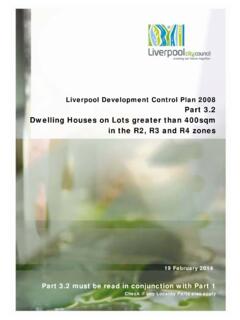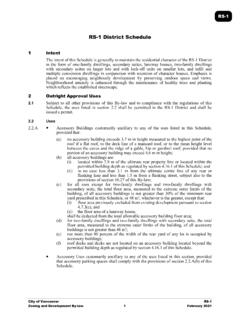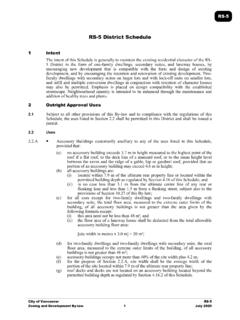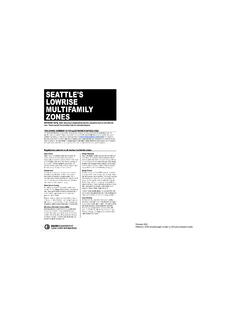Transcription of Side and rear setbacks for residential development
1 Information Sheet January 2015 Page 1 of 5 Side and rear setbacks for residential development This information sheet explains the requirements for side and rear building setbacks for a dwelling house and its ancillary development , under complying development in the General Housing Code. Important note This information sheet is for guidance only and may not contain all the information relevant to every property in NSW. Applicants should refer to the relevant planning controls1 before beginning work, or seek professional advice on how the planning controls apply to their property. The majority of the development that can be done as exempt or complying development in NSW is identified in the State wide exempt and complying development policy (the policy).
2 View the policy at the Exempt and Complying development Policy website2. Exempt development is minor building work that does not need planning or building approval. Information sheet provides more information about exempt development . Complying development is a joint planning and construction approval that can be granted by council or a private certifier. Information sheet provides more information about complying development . Note: As identified in Information Sheets and exempt and complying development cannot be carried out on certain land. 1 2 3 4 Side and rear setbacks Single and two storey dwelling houses may be constructed as complying subject to meeting specific development standards.
3 The side and rear setbacks required by the policy determine the location of houses and ancillary outbuildings (for example, sheds and garages) on a residential lot. A setback is the horizontal distance (measured at 90 degrees) from a lot boundary to a development . The policy provides for exceptions to setbacks for minor developments and building elements that may be located within the required setback. The policy also includes a number of exclusions and specific requirements to be met in relation to the development of certain land. Refer to Information Sheet for detail on exclusions and requirements that apply to different types of land. Lot requirements New houses, additions to existing houses and ancillary development can only be constructed as complying development on lots that are at least 200m2.
4 A built to boundary wall or boundary wall is a wall within 450mm of a boundary. Buildings that are built to a common side boundary have specific requirements based on the boundary walls (if any) on an adjoining. This ensures they do not have an adverse impact on neighbouring lots. Lots that have a rear boundary with a lane that has a width greater than 3m but less than 7m and is used primarily for access to the rear of Information Sheet January 2015 Page 2 of 5 the premises may have development that is built to that rear boundary. Side setbacks for residential development Side setbacks are determined by the width of the lot, measured at the building line and by the building height.
5 When calculating the setback, the height of the building is taken at the point closest to the boundary and not overall height of the building. Generally, the minimum side setback for development is 900m (read about exceptions to this below). Depending on the lot width, a house or outbuilding over a certain height above existing ground level must be set back further than the minimum 900mm. Table 1: Minimum required side setbacks for residential development Lot width With height of a building Nominal setback 6m 10m Up to 900mm 10m 18m Up to 900mm 18m 24m Up to 24m At any height If the building exceeds the heights in the above table, an additional setback must be provided.
6 This is determined by taking one-quarter of the additional height of the building above the height in the above table and adding it to the required setback. Figure 1: Example showing where built to boundary development is allowed on lots between 6m and 8m wide Example The additional height for a building height of is 3m ( 3m above Measuring the setback for a point in a building that has a height of , on a site with a lot width of 14m: The minimum required setback for the height of a building up to is 900mm. One quarter of 3m is 750mm Add 750mm to the minimum 900mm setback and the required setback for any point of a building with a height of is Information Sheet January 2015 Page 3 of 5 Figure 2: How to calculate minimum required side setbacks for dwelling houses, by lot width Where residential buildings can be built boundary to boundary Built to boundary walls is a reference to the provisions of the policy which allow walls of a building to be built to a common side boundary between two properties.)
7 This enables a more efficient use of land for narrower blocks. Lots that have a width that is at least 6m but not more than 8m wide may build to both side boundaries. Lots that are more than 8m but not more than may build to a single side boundary, subject to meeting the restrictions on the length and height of walls, as shown in Figure 2. A built to boundary wall is not permitted under the policy if the adjoining lot has a building wall within 900mm of the boundary that is not of masonry construction, or if it has a window facing the common boundary. Height Generally, boundary walls cannot be higher than above existing ground level.
8 However, boundary walls that adjoin an existing neighbouring boundary wall, can be built to the same height, if that the adjoining wall is higher than If the CDC is for multiple houses on adjoining lots, the boundary walls must have the same height. Length/Depth The length of boundary walls on a side boundary on lots that are at least 6m but not more than 10m are restricted to 20m or 50% of the lot depth, whichever is the lesser. For lots that are more than 10m but not more than wide, the length of the boundary wall is restricted to 10m. Similar to the allowances for boundary wall height, if the boundary wall is built to an existing boundary wall, then the total length of the new wall or walls may be longer than 20m or 50% of the lot depth, but not be longer than the existing neighbouring wall.
9 If the CDC is for multiple houses on multiple adjoining lots, the boundary walls must have the same length. Figure 3: Maximum lengths allowed for built to boundary walls on lots between 10m and wide The maximum length of built to boundary walls when a lot is either 6 to 8metres wide or 10 to wide are: For lots between 6-10m, a+b <20m or 50% of lot depth. For lots between 10m-12m, a+b<10. Information Sheet January 2015 Page 4 of 5 Rear setbacks The policy provides separate rear setback provisions for houses and ancillary outbuildings. Rear setbacks are based on the area of the lot and ensure that a development is provided with a reasonably sized back yard for the size of the lot, whilst protecting the amenity of adjoining houses.
10 Table 2: Minimum rear setback requirements for dwelling houses by lot area Building height up to: 200m2 300m2 >300m2 900m2 >900m2 1500m2 >1500m2 3m 3m 5m 10m Average* or 10m 8m 12m 15m *Average of the first floor rear setbacks of the two nearest dwelling houses. Table 3: Minimum rear setback requirements for outbuildings by lot area Building height up to: 200m2 300m2 >300m2 900m2 >900m2 1500m2 >1500m2 0mm* > 0mm+ 900mm* * * > 900mm+ + + * Nominal setback + Additional setback required to the nominal setback. Rear setbacks for outbuildings above a certain height ( or ) are based on taking one-quarter of the additional height and adding it to the nominal setback. Figure 4: Section showing the minimum rear setback requirements for dwelling houses (the maximum allowed building envelope is shown in red) setbacks from rear lanes development on lots that have a boundary with a rear lane may include buildings built to the rear lane boundary; however buildings are limited to a maximum of 50% of the length of that boundary.







